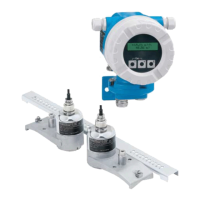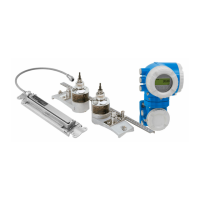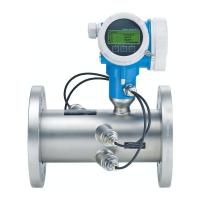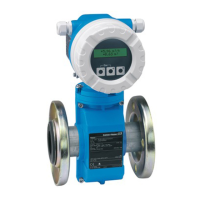PROline Prosonic Flow 93 FOUNDATION Fieldbus 4 Analog Input function block
Endress+Hauser 161
The Analog Input function block receives its input value from the Transducer Blocks
TRANSDUCER_CH1 (flow channel 1, base index 1200), TRANSDUCER_ CH2 (flow
channel 2, base index 1300) or TRANSDUCER_TOT (flow channel 1, base index 1550).
The CHANNEL parameter (see Page 171) is used to select which input value is to be
processed by the Analog Input function block.
The SIMULATE parameter group, (see Page 179), allows you to replace the input value
with a simulation value and to activate simulation. By specifying the status and the
simulation value, the reaction of the complete Analog Input function block can be
tested.
Note!
The simulation mode is enabled by means of jumpers on the I/O board, (see Operating
Instructions for PROline Prosonic Flow 93 FF, BA078D/06/en, Section 5.4).
The L_TYPE parameter is used to select the linearisation type of the input or simulation
value, (see Page 174):
• Direct signal conversion
The input value is forwarded without conversion (XD_SCALE = OUT_SCALE). Select
this option if the input value is already in the physical units you want.
• Indirect signal conversion
With this setting the input value is re-scaled linearly via the XD_SCALE input scaling
to the desired OUT_SCALE output range, (further information on rescaling of the input
value can be found on Page 165).
• Indirect signal conversion with root
With this setting the input value is re-scaled via the XD_SCALE parameter group and
recalculated using a root function. It is then rescaled again to the desired output range
via the OUT_SCALE parameter group.
The LOW_CUT parameter, (see Page 177), allows a limit value to be specified for the
low flow cut off. The low flow cut off is activated via the IO_OPTS parameter,
(see Page 173). If the converted primary value (PV) is below the limit value then it is set
to a value of "0".
In the PV_FTIME parameter, (see Page 178), a filter time can be specified for filtering the
converted input value (PV). If a time of 0 seconds is specified then no filtration takes
place.
• CHANNEL = 2 → Volume flow channel 1
• CHANNEL = 21 → Sound velocity channel 1
• CHANNEL = 23 → Flow velocity channel 1
• CHANNEL = 30 → Signal strength channel 1
• CHANNEL = 20 → Volume flow channel 2
• CHANNEL = 22 → Sound velocity channel 2
• CHANNEL = 24 → Flow velocity channel 2
• CHANNEL = 31 → Signal strength channel 2
• CHANNEL = 7 → Totalizer 1
• CHANNEL = 8 → Totalizer 2
• CHANNEL = 9 → Totalizer 3
• CHANNEL = 25 → Average volume flow
• CHANNEL = 26 → Volume flow sum
• CHANNEL = 27 → Volume flow difference
• CHANNEL = 28 → Average sound velocity
• CHANNEL = 29 → Totaliz er 1

